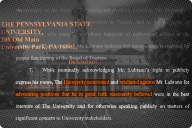You have /5 articles left.
Sign up for a free account or log in.
College is not free, and never will be. Someone is always paying -- taxpayers, private donors, students or some mix of the three. That obvious truth is missing from much of our political debate and the growing panic over student loans, which casts education debt as a tragedy rather than an investment. The hardening rhetoric against student loans threatens to undermine national success in broadening access to higher education, discouraging the very students we need.
This may sound strange coming from someone whose signature career achievement is a no-loans aid program. The whole idea behind the Carolina Covenant, which we launched at the University of North Carolina at Chapel Hill in 2003, was to assuage growing worry about student debt by eliminating loans for our lowest-income students.
But if we’re going to put higher education within reach of the millions more who would benefit, loans are going to be a crucial part of the equation. And that means students from all backgrounds -- especially low-income, first-generation and minority students -- need to understand reasonable student debt as an opportunity, not a crushing burden.
Middle- and upper-income families already have that view, which is why they’ve been willing to shoulder modest loans to earn valuable degrees. The vast majority of the increase in aggregate debt over the past few years -- the much-decried $1.3 trillion in student debt -- has come from more Americans pursuing a degree, a public policy success we ought to be celebrating. Millions of Americans have correctly seen higher education as a bridge to a better future.
For low-income and first-generation students, that bridge too often looks like a trap. Even modest loans can be frightening for families that have no experience of college investment, so they’re less willing to take that step. Overblown angst about debt threatens to entrench this class divide in ways that will prove deeply destructive to American higher education.
The promise of a no-loans education is as much about communication as about financing. For our lowest-income students at Carolina, it was meant to overcome the impression of debt as a hardship and a barrier. Our own research showed that it wasn’t a hardship -- students taking out modest loans for a quality education are almost invariably better off. But the perception was so strong among historically disadvantaged families that a no-loans promise for those students made sense.
We’re fortunate to have the resources for such a program, but most colleges and universities don’t -- especially not the regional public universities and community colleges that serve a disproportionate share of first-generation and minority students. If we’re going to move the needle on college access in the United States -- and we must, given our shifting demographics and the economic stakes -- then families have to get comfortable with personal investment in education.
That was certainly the story for my family many years ago. Having grown up in a small Midwest farming community with no resources for college, I took out more than $6,000 to cover my undergraduate education -- a sum that exceeds $41,000 in today’s dollars. And then there was the follow-on debt for graduate and professional education. It was scary, but it was also a privilege to use someone else’s money to improve my life. And that, fundamentally, is what students are doing when they use student loans to pursue an education.
If a “no loans” sentiment takes hold among students and policy makers, it will undermine access to college and make stories like mine less likely. It would reverse the democratization of higher education, devastating community colleges and public universities that are already stretched thin in their effort to serve a diversifying student body.
We badly need a more focused conversation about the right balance of taxpayer money, donor support and other university funds that can offset the cost to students. But in any scenario I can envision, short of creating a true K-16 entitlement, student loans are going to remain a necessary part of the mix.
If we cut off opportunity capital in the name of protecting students or taxpayers, we will end up with less opportunity. The relatively few families who can afford it will continue to buy high-quality, immersive education for their children. And others -- no matter how talented, no matter how driven -- will be left with meager options.
That would be a tragedy, not an improvement. The lamentations of the antidebt crowd assume that policy makers will ride to the rescue with new funding, but it won’t happen. Money is not that plentiful any more -- not from the states, and not from the federal government, despite what some of the presidential campaigns have promised. The students who benefit from higher education are going to remain personally invested, and there’s nothing regrettable about that.
We should stop scaring families with misleading tales of ruinous debt, and stop heeding pundits who would prefer to make education a rarefied luxury. When it comes to opening doors for our most vulnerable students, responsible borrowing is a solution, not a problem.








